PHI-413V Case Study: Examining Moral Status in Fetal Abnormality
VerifiedAdded on 2023/06/09
|5
|1226
|88
Case Study
AI Summary
This case study analyzes the moral status of a fetus with abnormalities, focusing on the perspectives of Jessica (the mother), Marco (the father), Maria (the aunt), and Dr. Wilson. Jessica leans towards pro-choice, while Marco supports her decision, influenced by patriarchal values. Maria adopts a pro-life stance rooted in religious beliefs, and Dr. Wilson advocates for situational abortion, considering the fetus's condition. The analysis explores the conflict between these viewpoints, ultimately supporting the pro-choice theory and prioritizing the mother's autonomy in making informed decisions about her pregnancy. The study concludes that considering the mother's autonomy and adhering to the situational abortion theory ensures optimal health outcomes. Desklib offers a range of solved assignments and past papers for students.
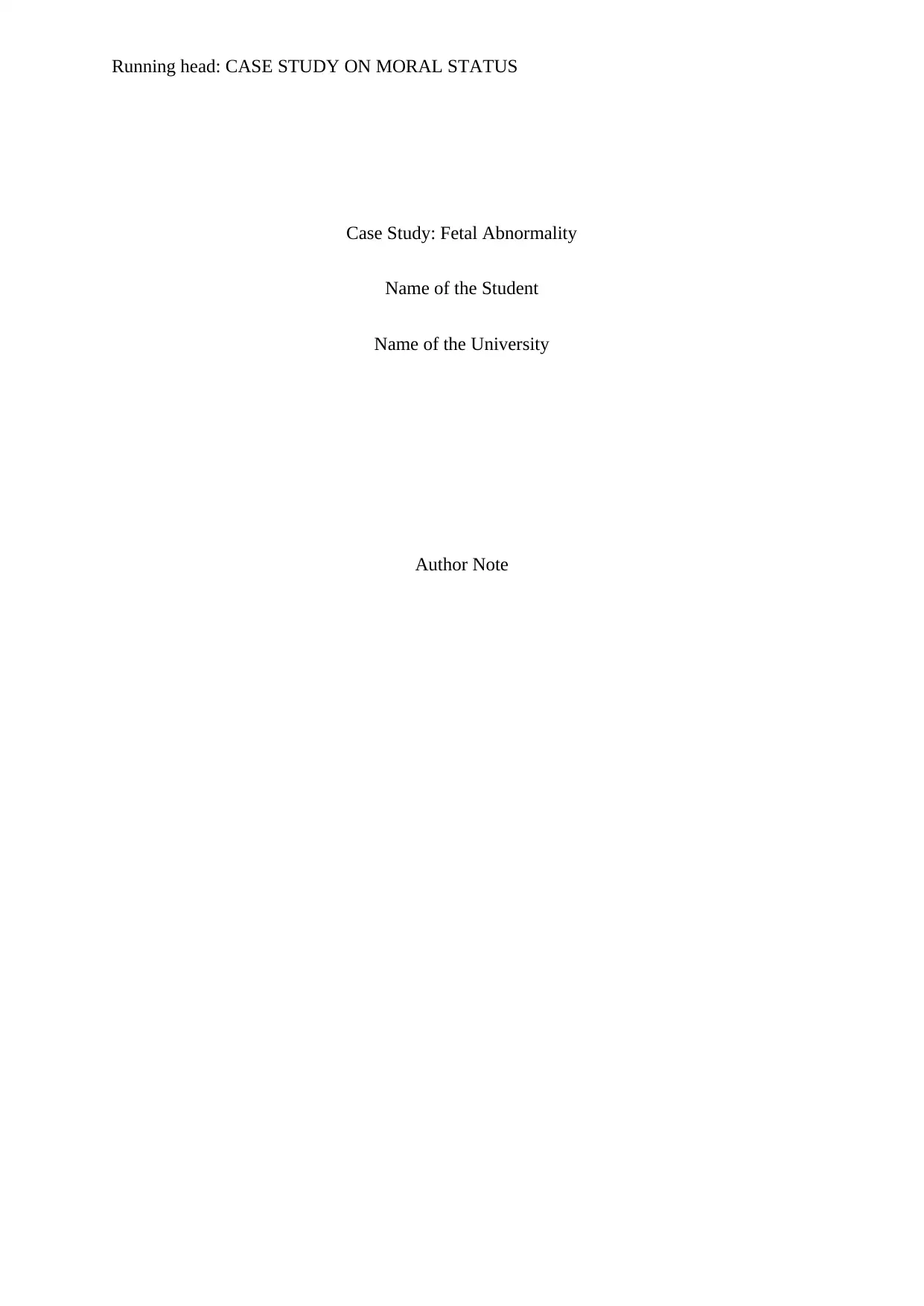
Running head: CASE STUDY ON MORAL STATUS
Case Study: Fetal Abnormality
Name of the Student
Name of the University
Author Note
Case Study: Fetal Abnormality
Name of the Student
Name of the University
Author Note
Paraphrase This Document
Need a fresh take? Get an instant paraphrase of this document with our AI Paraphraser
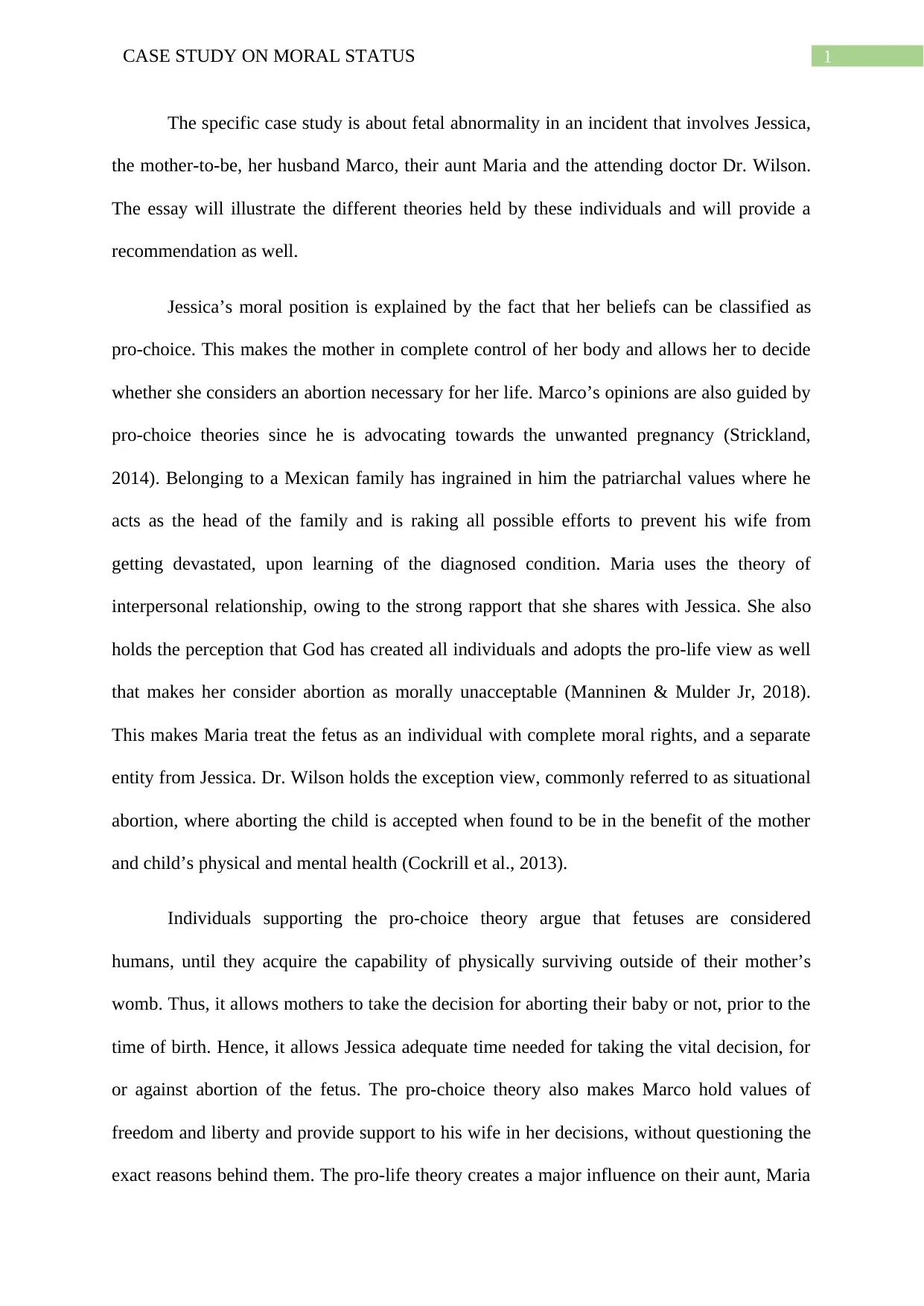
1CASE STUDY ON MORAL STATUS
The specific case study is about fetal abnormality in an incident that involves Jessica,
the mother-to-be, her husband Marco, their aunt Maria and the attending doctor Dr. Wilson.
The essay will illustrate the different theories held by these individuals and will provide a
recommendation as well.
Jessica’s moral position is explained by the fact that her beliefs can be classified as
pro-choice. This makes the mother in complete control of her body and allows her to decide
whether she considers an abortion necessary for her life. Marco’s opinions are also guided by
pro-choice theories since he is advocating towards the unwanted pregnancy (Strickland,
2014). Belonging to a Mexican family has ingrained in him the patriarchal values where he
acts as the head of the family and is raking all possible efforts to prevent his wife from
getting devastated, upon learning of the diagnosed condition. Maria uses the theory of
interpersonal relationship, owing to the strong rapport that she shares with Jessica. She also
holds the perception that God has created all individuals and adopts the pro-life view as well
that makes her consider abortion as morally unacceptable (Manninen & Mulder Jr, 2018).
This makes Maria treat the fetus as an individual with complete moral rights, and a separate
entity from Jessica. Dr. Wilson holds the exception view, commonly referred to as situational
abortion, where aborting the child is accepted when found to be in the benefit of the mother
and child’s physical and mental health (Cockrill et al., 2013).
Individuals supporting the pro-choice theory argue that fetuses are considered
humans, until they acquire the capability of physically surviving outside of their mother’s
womb. Thus, it allows mothers to take the decision for aborting their baby or not, prior to the
time of birth. Hence, it allows Jessica adequate time needed for taking the vital decision, for
or against abortion of the fetus. The pro-choice theory also makes Marco hold values of
freedom and liberty and provide support to his wife in her decisions, without questioning the
exact reasons behind them. The pro-life theory creates a major influence on their aunt, Maria
The specific case study is about fetal abnormality in an incident that involves Jessica,
the mother-to-be, her husband Marco, their aunt Maria and the attending doctor Dr. Wilson.
The essay will illustrate the different theories held by these individuals and will provide a
recommendation as well.
Jessica’s moral position is explained by the fact that her beliefs can be classified as
pro-choice. This makes the mother in complete control of her body and allows her to decide
whether she considers an abortion necessary for her life. Marco’s opinions are also guided by
pro-choice theories since he is advocating towards the unwanted pregnancy (Strickland,
2014). Belonging to a Mexican family has ingrained in him the patriarchal values where he
acts as the head of the family and is raking all possible efforts to prevent his wife from
getting devastated, upon learning of the diagnosed condition. Maria uses the theory of
interpersonal relationship, owing to the strong rapport that she shares with Jessica. She also
holds the perception that God has created all individuals and adopts the pro-life view as well
that makes her consider abortion as morally unacceptable (Manninen & Mulder Jr, 2018).
This makes Maria treat the fetus as an individual with complete moral rights, and a separate
entity from Jessica. Dr. Wilson holds the exception view, commonly referred to as situational
abortion, where aborting the child is accepted when found to be in the benefit of the mother
and child’s physical and mental health (Cockrill et al., 2013).
Individuals supporting the pro-choice theory argue that fetuses are considered
humans, until they acquire the capability of physically surviving outside of their mother’s
womb. Thus, it allows mothers to take the decision for aborting their baby or not, prior to the
time of birth. Hence, it allows Jessica adequate time needed for taking the vital decision, for
or against abortion of the fetus. The pro-choice theory also makes Marco hold values of
freedom and liberty and provide support to his wife in her decisions, without questioning the
exact reasons behind them. The pro-life theory creates a major influence on their aunt, Maria
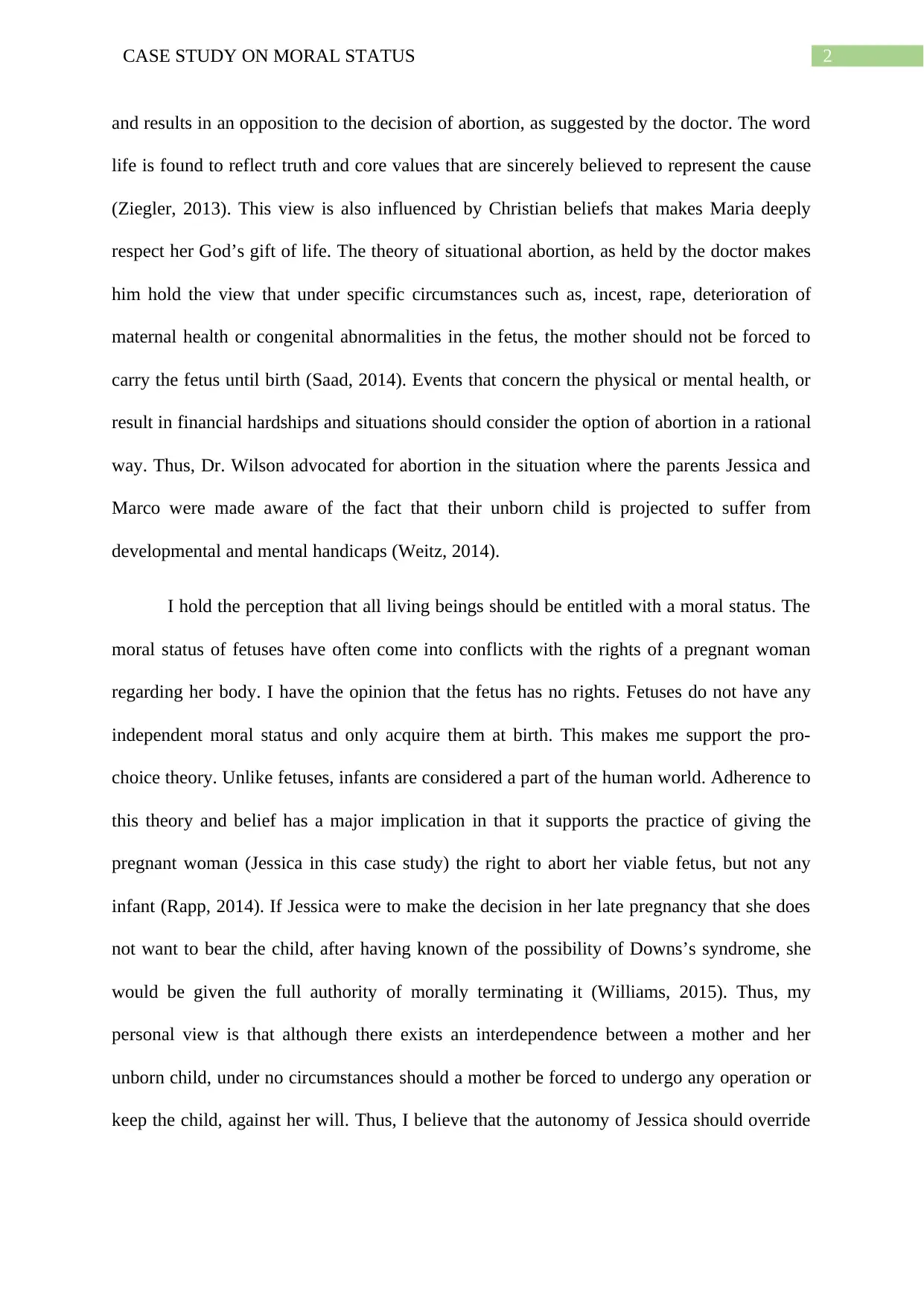
2CASE STUDY ON MORAL STATUS
and results in an opposition to the decision of abortion, as suggested by the doctor. The word
life is found to reflect truth and core values that are sincerely believed to represent the cause
(Ziegler, 2013). This view is also influenced by Christian beliefs that makes Maria deeply
respect her God’s gift of life. The theory of situational abortion, as held by the doctor makes
him hold the view that under specific circumstances such as, incest, rape, deterioration of
maternal health or congenital abnormalities in the fetus, the mother should not be forced to
carry the fetus until birth (Saad, 2014). Events that concern the physical or mental health, or
result in financial hardships and situations should consider the option of abortion in a rational
way. Thus, Dr. Wilson advocated for abortion in the situation where the parents Jessica and
Marco were made aware of the fact that their unborn child is projected to suffer from
developmental and mental handicaps (Weitz, 2014).
I hold the perception that all living beings should be entitled with a moral status. The
moral status of fetuses have often come into conflicts with the rights of a pregnant woman
regarding her body. I have the opinion that the fetus has no rights. Fetuses do not have any
independent moral status and only acquire them at birth. This makes me support the pro-
choice theory. Unlike fetuses, infants are considered a part of the human world. Adherence to
this theory and belief has a major implication in that it supports the practice of giving the
pregnant woman (Jessica in this case study) the right to abort her viable fetus, but not any
infant (Rapp, 2014). If Jessica were to make the decision in her late pregnancy that she does
not want to bear the child, after having known of the possibility of Downs’s syndrome, she
would be given the full authority of morally terminating it (Williams, 2015). Thus, my
personal view is that although there exists an interdependence between a mother and her
unborn child, under no circumstances should a mother be forced to undergo any operation or
keep the child, against her will. Thus, I believe that the autonomy of Jessica should override
and results in an opposition to the decision of abortion, as suggested by the doctor. The word
life is found to reflect truth and core values that are sincerely believed to represent the cause
(Ziegler, 2013). This view is also influenced by Christian beliefs that makes Maria deeply
respect her God’s gift of life. The theory of situational abortion, as held by the doctor makes
him hold the view that under specific circumstances such as, incest, rape, deterioration of
maternal health or congenital abnormalities in the fetus, the mother should not be forced to
carry the fetus until birth (Saad, 2014). Events that concern the physical or mental health, or
result in financial hardships and situations should consider the option of abortion in a rational
way. Thus, Dr. Wilson advocated for abortion in the situation where the parents Jessica and
Marco were made aware of the fact that their unborn child is projected to suffer from
developmental and mental handicaps (Weitz, 2014).
I hold the perception that all living beings should be entitled with a moral status. The
moral status of fetuses have often come into conflicts with the rights of a pregnant woman
regarding her body. I have the opinion that the fetus has no rights. Fetuses do not have any
independent moral status and only acquire them at birth. This makes me support the pro-
choice theory. Unlike fetuses, infants are considered a part of the human world. Adherence to
this theory and belief has a major implication in that it supports the practice of giving the
pregnant woman (Jessica in this case study) the right to abort her viable fetus, but not any
infant (Rapp, 2014). If Jessica were to make the decision in her late pregnancy that she does
not want to bear the child, after having known of the possibility of Downs’s syndrome, she
would be given the full authority of morally terminating it (Williams, 2015). Thus, my
personal view is that although there exists an interdependence between a mother and her
unborn child, under no circumstances should a mother be forced to undergo any operation or
keep the child, against her will. Thus, I believe that the autonomy of Jessica should override
⊘ This is a preview!⊘
Do you want full access?
Subscribe today to unlock all pages.

Trusted by 1+ million students worldwide
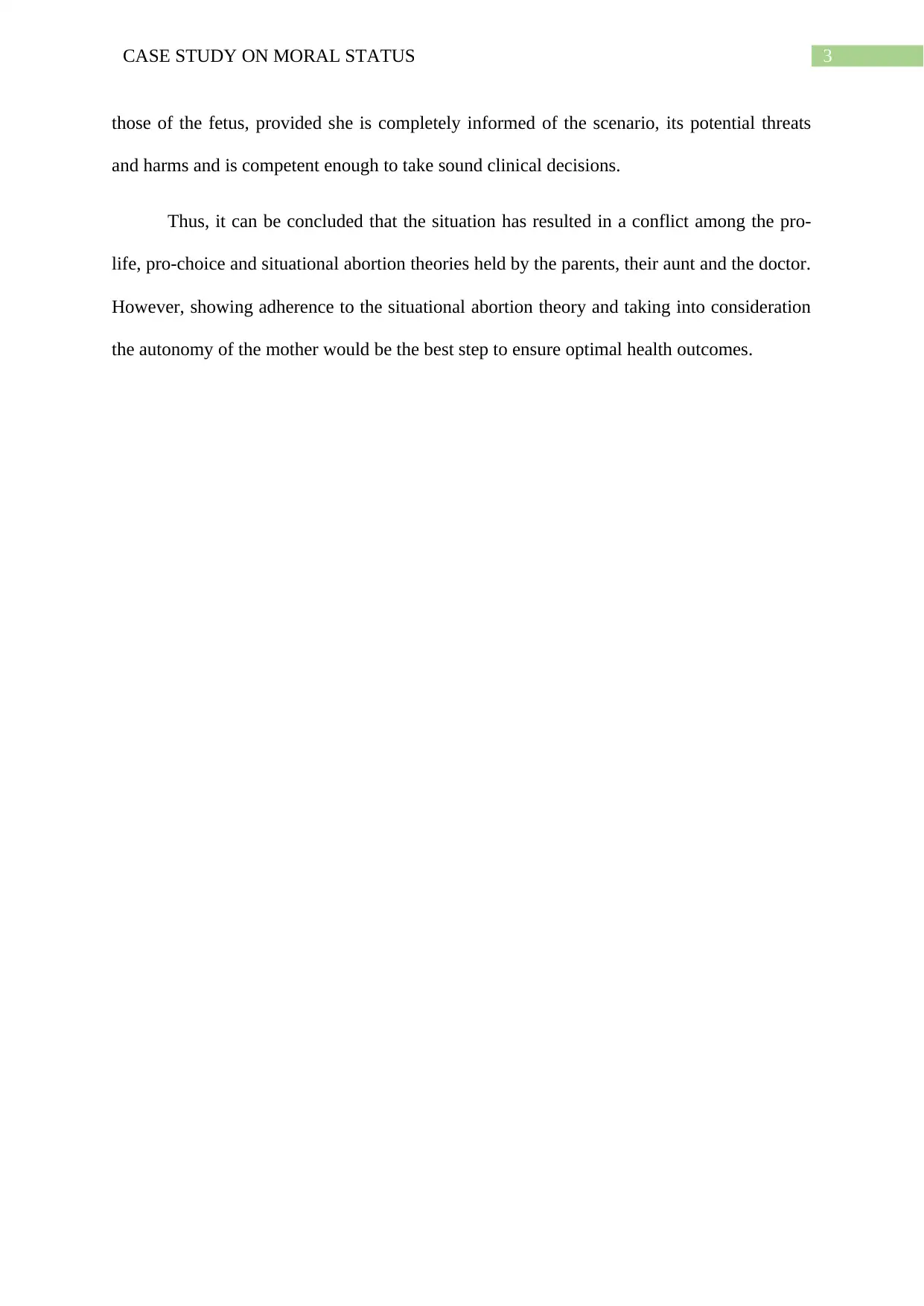
3CASE STUDY ON MORAL STATUS
those of the fetus, provided she is completely informed of the scenario, its potential threats
and harms and is competent enough to take sound clinical decisions.
Thus, it can be concluded that the situation has resulted in a conflict among the pro-
life, pro-choice and situational abortion theories held by the parents, their aunt and the doctor.
However, showing adherence to the situational abortion theory and taking into consideration
the autonomy of the mother would be the best step to ensure optimal health outcomes.
those of the fetus, provided she is completely informed of the scenario, its potential threats
and harms and is competent enough to take sound clinical decisions.
Thus, it can be concluded that the situation has resulted in a conflict among the pro-
life, pro-choice and situational abortion theories held by the parents, their aunt and the doctor.
However, showing adherence to the situational abortion theory and taking into consideration
the autonomy of the mother would be the best step to ensure optimal health outcomes.
Paraphrase This Document
Need a fresh take? Get an instant paraphrase of this document with our AI Paraphraser
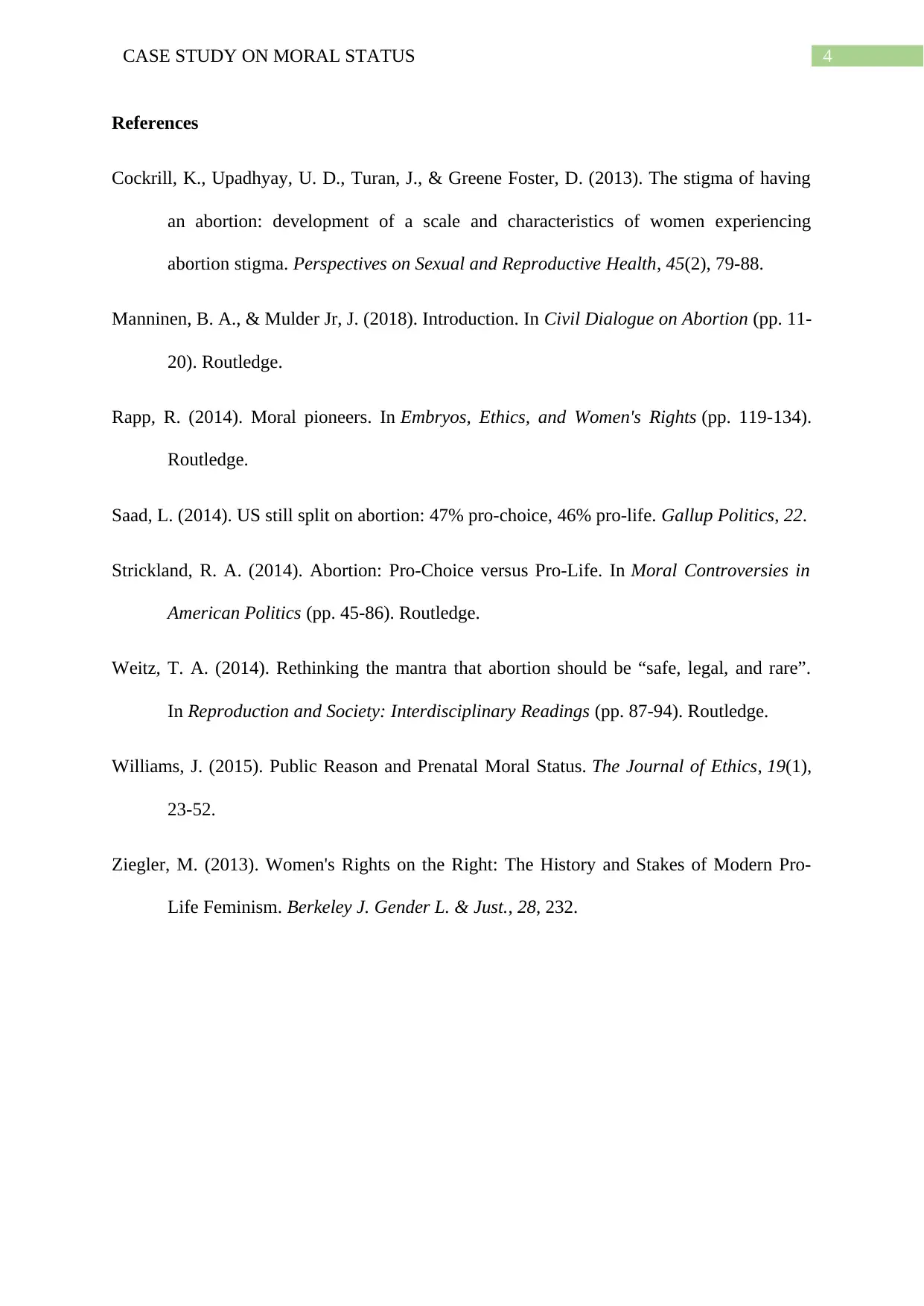
4CASE STUDY ON MORAL STATUS
References
Cockrill, K., Upadhyay, U. D., Turan, J., & Greene Foster, D. (2013). The stigma of having
an abortion: development of a scale and characteristics of women experiencing
abortion stigma. Perspectives on Sexual and Reproductive Health, 45(2), 79-88.
Manninen, B. A., & Mulder Jr, J. (2018). Introduction. In Civil Dialogue on Abortion (pp. 11-
20). Routledge.
Rapp, R. (2014). Moral pioneers. In Embryos, Ethics, and Women's Rights (pp. 119-134).
Routledge.
Saad, L. (2014). US still split on abortion: 47% pro-choice, 46% pro-life. Gallup Politics, 22.
Strickland, R. A. (2014). Abortion: Pro-Choice versus Pro-Life. In Moral Controversies in
American Politics (pp. 45-86). Routledge.
Weitz, T. A. (2014). Rethinking the mantra that abortion should be “safe, legal, and rare”.
In Reproduction and Society: Interdisciplinary Readings (pp. 87-94). Routledge.
Williams, J. (2015). Public Reason and Prenatal Moral Status. The Journal of Ethics, 19(1),
23-52.
Ziegler, M. (2013). Women's Rights on the Right: The History and Stakes of Modern Pro-
Life Feminism. Berkeley J. Gender L. & Just., 28, 232.
References
Cockrill, K., Upadhyay, U. D., Turan, J., & Greene Foster, D. (2013). The stigma of having
an abortion: development of a scale and characteristics of women experiencing
abortion stigma. Perspectives on Sexual and Reproductive Health, 45(2), 79-88.
Manninen, B. A., & Mulder Jr, J. (2018). Introduction. In Civil Dialogue on Abortion (pp. 11-
20). Routledge.
Rapp, R. (2014). Moral pioneers. In Embryos, Ethics, and Women's Rights (pp. 119-134).
Routledge.
Saad, L. (2014). US still split on abortion: 47% pro-choice, 46% pro-life. Gallup Politics, 22.
Strickland, R. A. (2014). Abortion: Pro-Choice versus Pro-Life. In Moral Controversies in
American Politics (pp. 45-86). Routledge.
Weitz, T. A. (2014). Rethinking the mantra that abortion should be “safe, legal, and rare”.
In Reproduction and Society: Interdisciplinary Readings (pp. 87-94). Routledge.
Williams, J. (2015). Public Reason and Prenatal Moral Status. The Journal of Ethics, 19(1),
23-52.
Ziegler, M. (2013). Women's Rights on the Right: The History and Stakes of Modern Pro-
Life Feminism. Berkeley J. Gender L. & Just., 28, 232.
1 out of 5
Related Documents
Your All-in-One AI-Powered Toolkit for Academic Success.
+13062052269
info@desklib.com
Available 24*7 on WhatsApp / Email
![[object Object]](/_next/static/media/star-bottom.7253800d.svg)
Unlock your academic potential
Copyright © 2020–2025 A2Z Services. All Rights Reserved. Developed and managed by ZUCOL.




